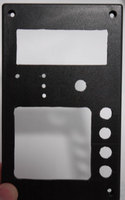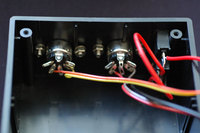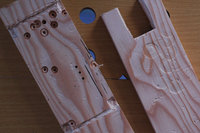MIDI and Audio
G2 MIDI Controller

MIDI and AudioG2 MIDI Controller | 
|
I own a Nord G2 Engine, and while it's a great synth, it lacks all of the user interface coolness of the G2 or G2X keyboards. There's no way to select a patch except blindly using bank/program select from another synth, or by having a computer tied to it to display the patch listings.
I've overcome this problem by building a AVR-based MIDI controller that can get patch names from the G2 with MIDI, display a patch name on the screen, and let you load it into a slot on the G2.
These are the major components in the controller:
Building kits into the sort of thermo plastic hobby box makes things easier, but the finish isn't great. For a first prototype, it's fine. Drilling large holes in the front of this plastic can cause the plastic to split and crack so I made up a wood jig out of pine, and used a dremel to cut slots so the lid fitted into it firmly. The fork-shaped piece of wood is clamped to the top for support when drilling between the tines.

|

|

|
| Empty front panel | MIDI plugs and power | Jig for drilling front panel |